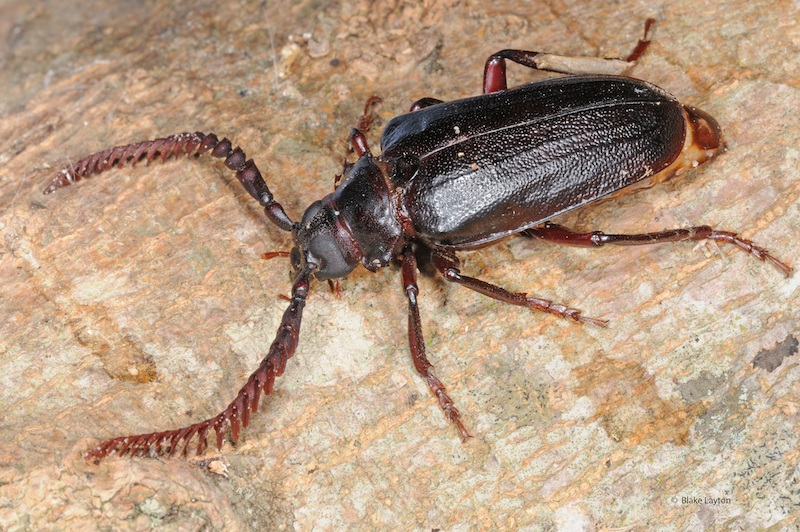Tile-horned Prionus Beetle, Vol. 8, No. 26
Prionus imbricornis
Order: Coleoptera
Family: Cerambycidae
These are big, heavy-bodied beetles. Males can be up to 1.5 inches long, not counting the antennae, and females reach two inches, but those long, thick antennae make them look even bigger. They belong to the large family of beetles, Cerambycidae, which are also called “long-horned beetles” because of their unusually long antennae. Tile-horned prionus beetles are our largest long-horned beetle, and one of the largest insects in the state. The largest beetle in the world also belongs to this family. Titan beetles, Titanus giganteus, from South America, look much like tile-horned prionus beetles, only bigger—up to six inches long. Yes, you really should google a photo of someone holding one of these.
Despite their size, tile-horned prionus beetles are rarely seen because they are active at night and hide during the day. Males use those big antennae to locate females, and females lay eggs in the soil around pecan, hickory, and oak trees.
The larvae feed on tree roots, taking around three to five years to grow to maturity and pupate. They cause damage by boring, girdling and killing large lateral roots, and even tap roots, causing trees to decline over time. Mature larvae can exceed four inches, and larvae this size chew holes and galleries bigger than a man’s finger. This can be a particular problem in older pecan orchards, as well as in apple orchards farther north. Pecan trees suffering heavy root borer infestations often have thinning canopies and dying limbs. Trees that have had several of their large lateral roots killed by root borers will not be as productive as trees with intact root systems, and they will be more susceptible to wind damage.
Although prionus root borers occur on trees growing in forest settings throughout the South, trees growing in more open settings, such as landscapes and orchards, seem to be more prone to attack and damage. The next time you see a large oak or pecan tree that has recently been toppled by wind, check it out for signs of root borer damage to the large lateral roots. Heavily infested roots may be completely hollowed out or riddled with large galleries. The broad-necked root borer, Prionus laticollis, is a slightly smaller species that causes similar damage.
Control: Until recently, commercial pecan growers could control prionus root borers by spraying the orchard floor with chlorpyrifos. The objective was to kill newly mated females as they crawled through treated soil and before they could lay eggs. But this and all other uses of chlorpyrifos on food crops was canceled in February of 2022. Currently the only control available to commercial growers is mass trapping with pheromone traps baited with lures containing prionic acid to confuse males and prevent mating.
Twig Girdler is another, smaller, long-horned beetle that damages pecan, oak, and other hardwoods in a unique way.
Blake Layton, Extension Entomology Specialist, Mississippi State University Extension Service.
The information given here is for educational purposes only. Always read and follow current label directions. Specific commercial products are mentioned as examples only and reference to specific products or trade names is made with the understanding that no discrimination is intended to other products that may also be suitable and appropriately labeled. Mississippi State University is an equal opportunity institution.
Bug’s Eye View is now on Facebook. Join the Bug's Eye View Facebook group here.


